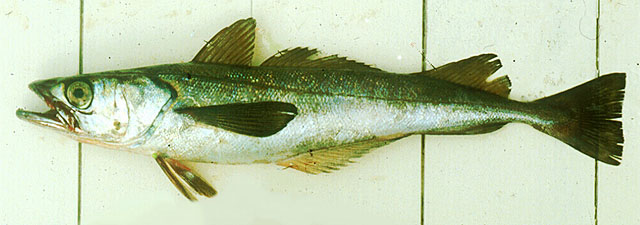| Merlucciidae (Merluccid hakes) |
| 87 cm TL (male/unsexed) |
|
bathydemersal; marine; depth range 50 - 500 m, oceanodromous |
| Southeast Pacific: off the coast of Chile from Arica to Chiloé Island. |
|
Dorsal spines (total): 1-1; Dorsal soft rays (total): 45-54; Anal spines: 0-0; Anal soft rays: 36-42; Vertebrae: 49-53. Caudal fin margin usually concave. Color is silvery on back, silvery whitish on belly. M. gayi gayi and M. gayi peruanus differ by the total number of vertebrae, total number of gill rakers and relative length of head (Ref. 1371). |
| Occurs from the shallow continental shelf to the upper continental slope (Ref. 1371). Sometimes found off the bottom or in midwater (Ref. 1371). Migrates vertically to midwater at night to feed on fishes, squids and euphausiids (Ref. 27363). Moves to southern coastal areas in summer and migrates to northern deeper waters (200-500 m depth) in winter and spring (Ref. 27363). Spawning occurs at the end of the winter and during the southern spring (Ref. 58452). Marketed fresh and frozen (Ref. 1371) and eaten steamed, fried, boiled and microwaved (Ref. 9988). Also utilized as fishmeal (Ref. 1371). |
|
Data deficient (DD); Date assessed: 01 May 2008 Ref. (130435)
|
| harmless |
Source and more info: www.fishbase.org. For personal, classroom, and other internal use only. Not for publication.
